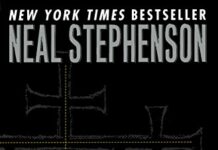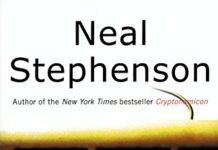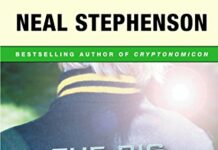
Ebook Info
- Published: 2008
- Number of pages: 1083 pages
- Format: PDF
- File Size: 16.24 MB
- Authors: Neal Stephenson
Description
Anathem, the latest invention by the New York Times bestselling author of Cryptonomicon and The Baroque Cycle, is a magnificent creation: a work of great scope, intelligence, and imagination that ushers readers into a recognizable — yet strangely inverted — world.Fraa Erasmas is a young avout living in the Concent of Saunt Edhar, a sanctuary for mathematicians, scientists, and philosophers, protected from the corrupting influences of the outside “saecular” world by ancient stone, honored traditions, and complex rituals. Over the centuries, cities and governments have risen and fallen beyond the concent’s walls. Three times during history’s darkest epochs violence born of superstition and ignorance has invaded and devastated the cloistered mathic community. Yet the avout have always managed to adapt in the wake of catastrophe, becoming out of necessity even more austere and less dependent on technology and material things. And Erasmas has no fear of the outside — the Extramuros — for the last of the terrible times was long, long ago.Now, in celebration of the week-long, once-in-a-decade rite of Apert, the fraas and suurs prepare to venture beyond the concent’s gates — at the same time opening them wide to welcome the curious “extras” in. During his first Apert as a fraa, Erasmas eagerly anticipates reconnecting with the landmarks and family he hasn’t seen since he was “collected.” But before the week is out, both the existence he abandoned and the one he embraced will stand poised on the brink of cataclysmic change.Powerful unforeseen forces jeopardize the peaceful stability of mathic life and the established ennui of the Extramuros — a threat that only an unsteady alliance of saecular and avout can oppose — as, one by one, Erasmas and his colleagues, teachers, and friends are summoned forth from the safety of the concent in hopes of warding off global disaster. Suddenly burdened with a staggering responsibility, Erasmas finds himself a major player in a drama that will determine the future of his world — as he sets out on an extraordinary odyssey that will carry him to the most dangerous, inhospitable corners of the planet . . . and beyond.
User’s Reviews
Reviews from Amazon users which were colected at the time this book was published on the website:
⭐** spoiler alert **I read Anathem eleven years ago (23-Nov-2011). Actually, I believe I listened to the audiobook during my daily workouts over the course of some weeks. It’s a long book — 1010 pages in kindle. Fellow Neal Stephenson fans will recognize this as nothing out of the ordinary for Stephenson. He is an author who writes long books, partly because he is always ready on the slightest provocation (or really, none at all) to leap into a 20-page treatise on orbital mechanics (Seveneves) or the genetics of North American feral pigs (Termination Shock). Those of us who love Stephenson recognize this as part of the experience and enjoy it. I would have thought the audience for this was small, but his books sell well and he’s harvested a not insignificant number of major awards.The premise of Anathem is that we live in a quantum multiverse. (This proposition may be true, for certain values of “true” — see From Eternity to Here by Sean Carroll and The Fabric of Reality by David Deutsch.) Furthermore, in Anathem these parallel universes can communicate through Platonic forms that are shared by all universes. This is also the premise of Charles Stross’s Laundry Files series, which is probably my all-time favorite science fiction series. The idea is that mathematical truths should be true in all universes. Thus in all universes 101 is a prime number, or, more esoterically, in every universe the smallest simple group of non-prime order has order 60.The idea that such logical commonalities may be used for communication has deep logical flaws. However, I am comfortable with the concept of fiction, so I’m happy to suspend disbelief. It helps that both Stephenson and Stross are clearly aware of the difficulties with the idea.In Anathem the universe is invaded from another universe. The avouts of the mathic world join with the extramuros of the saecular world to combat the invasion. (Anathem has many of these odd vocabs — the title “anathem” itself evokes the English words “anthem” and “anathema”, and this ambiguity is clearly intentional. The “mathic” world is composed of organizations that somewhat resemble monasteries, but the avouts pursue mathematical and scientific investigation.) One of the avouts who joins the battle, Fraa Jad, has a sort of quantum magic — he can influence which way quantum superpositions resolve, meaning that he has some ability to influence the direction of random events.I enjoyed it, a lot, but it’s not for everyone. There will be long sections that, for me, were full of fascinating ideas, but that will, I suspect, bore most readers to tears.
⭐AnanthemBy Neal StephensonThis book was recommended by my son Tj. His recommendation came with a general commentary that within it comes a moral code that he can identify with. It is a classic sci-fi involving the cosmos and numerous civilizations, where one alien civilization is in search of a natural resource, lost on their own planet, but found on a new planet. Hence the over arching dilemma of the rule of scarcity prevails. The setting of the story takes place on what would be presumed as future Earth, Stephenson eventually gives it a different name Arbre. Laced through the book are definitions of words inclusive of an epistemology that the reader must learn. These definitions build on each other in order to construct Stephenson’s moral code that has no bias to our history. However the effort is thinly veiled rendering the effort as obviously taking his own stand on philosophy. Which is oneness of societies. None the less the reader should be ware to learn the definitions them as you go. In doing so you get Stephensons moral message in a very entertaining way. It would not be a sci-fi without a moral message involving multiple civilizations.In one sentence: this book is about consciousness and cognition at brain, social and cosmos level rendering our thoughts with semantic content over and above the ones and the zeros, the black and the white that seem to define our thinking at theoric levelThis book is a tale of two philosophies coming together to save themselves from destruction. One magisterium is the Saecular Power. The other is the Mathic World – in joining hands for sake of survival, thee two are well – running the world? In shaping this dichotomy there is a theme of multiple upheavals in the history of man, that would amalgamate a set of rules for which peoples of certain Praxes and Concents (Stephenson defined terms) would abide by. Generational learning that is somewhat parallel to tradition, only with a mathematical line of reasoning. Stephenson layers the civilizations first on earth and then about two thirds of the way through the book he adds a new dimension; aliens from the cosmos. The prime characters hale from what is defined as a math. Maths take on every characteristic of a monastery, turning the common dichotomy of religion and science upside down whereby the main characters adopt the look and feel of a monk. The catch is monasteries and these monks in particular are science oriented with everything being mathematically explained. This explains my son who holds a Masters In Quantative Analysis, and a love for the book. While Math Monks live a reclusive life, seeing the outside world once every ten years, these main characters are expelled, or really sent out on a mission to save their world. The reader has to read 250 pages of life in a monastery to get to the next layer of intrigue, which is how well they survive in the outside world with common civilization as their allies and at times secular foes.Si-Fi’s usually have a quest so Stephenson uses a quest over the north pole to shape the alliance of Maths, and common folks. And then the plot turns on a dime with the smashing of giant rod into the earth, killing who up to then was the key protagonist and mentor to all those of the math. Orolo like Gandalf in Lord of the Rings is vanquished; meanwhile his ‘math (philosophy)’ lives on in the minds of the ‘math monks’. Now they in alliance with Arbre’s outside civilization, the mystery of Orlo’s movements and mission becomes real clear to the reader. Arbre has been invaded by an alien spaceship hovering above. The key word in the story is hovering and not orbiting, as that point gives the Arbrelings a strategic advantage that makes no logical sense to a reader who does not appreciate the finer points of the time & space part of earth science. A puzzle within a puzzle. That person puzzles over this fun fact only after finishing the last 300 pages of the book. The law of physics and time spins around objects in motion.So the strategy to foil the alien ship’s attack on Arbre involves objects in motion, and the concept of space time. It would be rude of me to go in to detail but suffice it to say that there is an incident that occurs in the planet saving mission that at the closing of the book, has the reader searching back to those critical pages for an explanation. Entwined with this explanation, is the thread of Stephenson’s philosophy and moral message. Alter realities are a theme of this book and in fact the alter reality or parallel plane exists through Jad in the end, where he lives and is a hero but in reality he dies. It involves time, space, and Oneness of the Universe and a Hylean Flow of consciousness through a Wick that transcends cosmi. All are intriguing subjects to me.Consciousness: “All it needs to do is to perceive – to reflect- the cosmos that it’s really in, as it really is.” This is the theme of my book of poems. And a quote from a recently read book, How Yoga Works: “all things are themselves by themselves” for you to awaken to. Oddly and still coincidently here again vouches the phrase. Seek and ye shall find” … in everyplace you look …even if coincidently.My favorite metaphor: I am tormented, or tantalized, by the sense that I’m almost in view of something that is at the limit of my comprehension. I dream of being in the sea, treading water, trying to see a beacon on shore. But the view is blocked by the crests of the waves. Sometimes, when conditions are perfect, I can pop up high enough to glimpse it. But then, before I can form any form impression of what it is I’m seeing, I sink back down of own weight, and get slapped in the face by another wave.On My blog Cigar Room of Books, keyword cigarroomofbooks, I have a bibliography of excerpts that shaped my review. I invite to to check it out and comment
⭐Wow! You’ll need to keep your head clear and focussed for this one!Less a thousand-page SF novel, more a 500-page SF novel interspersed with philosophical examinations of the ‘many worlds’ theory in quantum physics set out in the newly-invented (Arbran) terminology of the novel’s protagonists. ‘Anathem’ is no easy read and the sections using a ‘directed acyclic graph’ to explain how different timelines might physically influence each other had me reaching for the paracetamol as my brain cells exploded, but I made it to the end!I’m still not sure that, as a narrative, it entirely holds together, but if you persevere you’ll be a member of a pretty exclusive club of readers who can genuinely say they’ve read it all the way through, and that’s got to be worth adding to your CV.So, approach with caution, but be prepared to be amazed at the extraordinary work Neal Stephenson has wrought.
⭐Anathem excels in its worldbuilding. The mathic world Stephenson has created is novel and interesting. In a similar manner to a clockwork orange the book uses in universe slang and terminologies which you gradually come to understand over the course of the book. Unlike Clockwork Orange, Stephenson makes the effort to explain a term at the start of each chapter although a casual reader should be able to infer most from context well before the book takes the time to explain them.If the book made proper use of this setting it would be a fantastic novel. I could happily have read 1000 pages of Theors discussing their lives and politics, unfortunately the book veers off into a typical scifi adventure plot roughly 1/3rd through. From here it’s a slow descent but a descent nonetheless. Characters come and go, seemingly forgotten about for much of the story only to reappear to mill about aimlessly. Action scenes that play out like cheesy 90s hollywood movies are forced in. Chapters become less and less coherently linked and require ever more suspension of disbelief until a singularity of tropey scifi nonsense finishes off what started strong.Were this a shorter book it would be enough to render it nothing more than a mediocre scifi novel but the first third of the book alone makes this worth the read and even though the other 2/3rds can be found elsewhere, written better, reading it never became tedious.
⭐Anathem isn’t an easy book, and it’s not a quick read. Anathem, however, is very rewarding. A book I will definitely read a second time in a few years and then hopefully a third time, several years later. Neal Stephenson is obviously bursting with knowledge, and I had to look up the meaning of unknown words more than once. Cheers for expanding my vocabulary.The plot of Anathem takes place on a different planet than ours and Stephenson invented quite a few words to go with it. As a non native speaker I got to play the beloved ‘made up word or English word I do not yet know’ game. Thankfully the Kindle comes with a dictionary and Anathem comes with an extensive glossary.After about seventy pages, I felt more comfortable with the language, and the book started to flow. The world building is fantastic, the social commentary funny, and I thoroughly enjoyed the read.I recommend this to people who love alternative worlds, physics, philosophy and science. And by love, I mean really love.
⭐ANATHEM is a serious piece of science fiction – a vast, dense novel full of philosophy, maths and quantum physics that develops a novel ontological theory from the work of multiple philosophers and scientists from Earth’s past and somehow weaves it into a cracking sci-fi action adventure… eventually. The book starts off slowly, with the first 100 pages or so rich in detail and description, introducing us to Stephenson’s world and defining concepts and terminology… but not a lot exactly happens. The slow start is deceptive though, as once the characters’ normally stable reality gets disrupted, events gradually become more dramatic until the universe so carefully constructed at the start of the novel has been completely turned on its head.ANATHEM is definitely a novel of ideas… long sections involve little more than characters discussing philosophy, maths and physics, and some familiarity with those subjects is probably necessary if the reader is going to get the most out of it. Although the ideas are usually explained in the novel, familiarity with the earth-bound thinkers and theories that are being referenced would probably help with appreciating what they are talking about. Plato’s theory of forms and Hugh Everett’s many-worlds interpretation of Quantum Mechanics are particularly key subjects.ANATHEM is science fiction as it should be done – a well realised world which echoes but is not our own. It’s not just an adventure story with spaceships (though it is that too), it’s an exploration of ideas and concepts from across the spectrum of human intellectual endeavour, a book which challenges the reader to think. Neal Stephenson has done a commendable job taking a fairly hefty chunk of philosophy and science and converting it into a ripping yarn.
⭐This book is particularly problematic for me.It is a good read.It is very long.It is very well writtenBut – the story doesnt really start untill about a third of the book in. At that point you are wondering if you really want to be reading about a world where Scientific thought has become a monastic discipline involving segregation from the secular world for 1 , 10,100 or 1000 years at a time. Up till that point I thought a couple of times about giving up on it, interesting as it was – the discussions of philosphy ( of made up philisophical sects) was just going nowhere for several hundred pages. I did put it down for a while but after coming back it started getting more interesting.Theres a curious experiment going on here – where the roles of religion and science have reversed. The word Saunt is used to describe important thinkers in the past – many of whom have been martyred. The performing of miracles is the province of thinkers. This is all muddying the lines between Religion and Science. The use of slang – like Saunt is used to heighten the metaphor. Once the story pace cranks up and the actual meaning of saunt becomes apparent – the cloak of mysticism has already dropped away.Anyhow – the basis of the story is that the various personages of the book are living in a monastery populated by like minded thinkers. Those in the monastery are divided into different groups who do not interact outside of their group except for a short period every 1,10,100 or 1000 years. Except something happens at the monastery and One of the monks is declared Anathem and cast out (the title of the book). What then follows is a cosnpriacy story that become a global threat of the usual epic SF proportion.But its a very odd read. It goes from paceless to very fast paced. From philisophical to action.Honestly its a very odd read and definitely wont suit everyone. I honestly think the first 200 pages are desigend as an attention filter, to weed out those neal doesnt want reading his book.Stick with it.IMHO far better than any of his recent stuff – apart form REAMDE.
Keywords
Free Download Anathem in PDF format
Anathem PDF Free Download
Download Anathem 2008 PDF Free
Anathem 2008 PDF Free Download
Download Anathem PDF
Free Download Ebook Anathem




